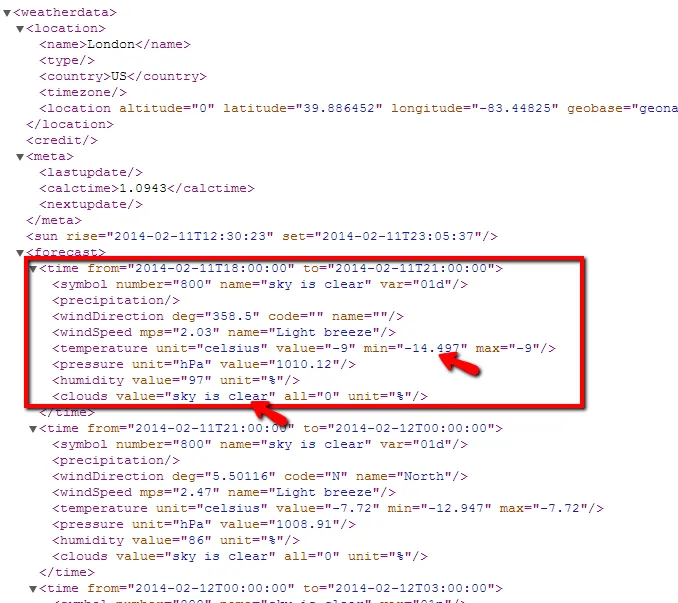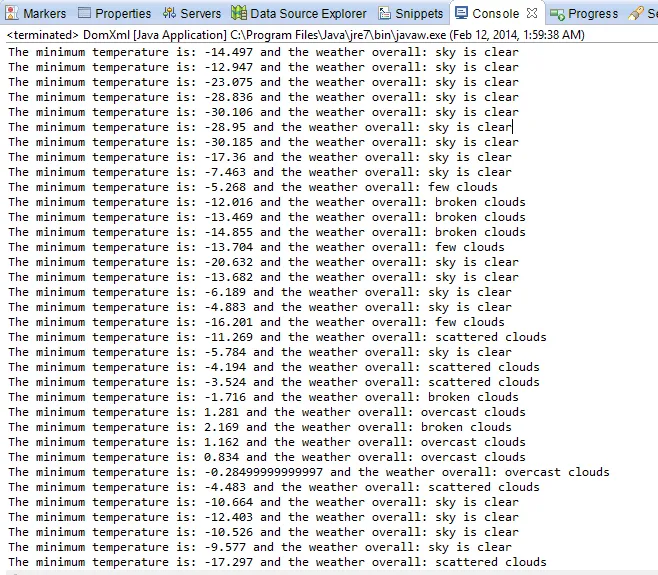您有几种实现Java XML解析的变体。
最常见的是:DOM,SAX,StAX。
每种方法都有其优缺点。使用Dom和Sax,您可以使用xsd模式验证您的xml。但是Stax可以在没有xsd验证的情况下工作,并且速度更快。
例如,xml文件:
<?xml version="1.0" encoding="UTF-8"?>
<staff xmlns:xsi="http://www.w3.org/2001/XMLSchema-instance"
xsi:noNamespaceSchemaLocation="oldEmployee.xsd">
<employee>
<name>Carl Cracker</name>
<salary>75000</salary>
<hiredate year="1987" month="12" day="15" />
</employee>
<employee>
<name>Harry Hacker</name>
<salary>50000</salary>
<hiredate year="1989" month="10" day="1" />
</employee>
<employee>
<name>Tony Tester</name>
<salary>40000</salary>
<hiredate year="1990" month="3" day="15" />
</employee>
</staff>
在我的印象中,最慢的实现方式是 DOM 解析器:
class DomXmlParser {
private Document document;
List<Employee> empList = new ArrayList<>();
public SchemaFactory schemaFactory;
public final String JAXP_SCHEMA_LANGUAGE = "http://java.sun.com/xml/jaxp/properties/schemaLanguage";
public final String W3C_XML_SCHEMA = "http://www.w3.org/2001/XMLSchema";
public DomXmlParser() {
try {
DocumentBuilderFactory factory = DocumentBuilderFactory.newInstance();
factory.setNamespaceAware(true);
factory.setAttribute(JAXP_SCHEMA_LANGUAGE, W3C_XML_SCHEMA);
DocumentBuilder builder = factory.newDocumentBuilder();
document = builder.parse(new File(EMPLOYEE_XML.getFilename()));
} catch (Exception e) {
e.printStackTrace();
}
}
public List<Employee> parseFromXmlToEmployee() {
NodeList nodeList = document.getDocumentElement().getChildNodes();
for (int i = 0; i < nodeList.getLength(); i++) {
Node node = nodeList.item(i);
if (node instanceof Element) {
Employee emp = new Employee();
NodeList childNodes = node.getChildNodes();
for (int j = 0; j < childNodes.getLength(); j++) {
Node cNode = childNodes.item(j);
if (cNode instanceof Element) {
switch (cNode.getNodeName()) {
case "name":
emp.setName(text(cNode));
break;
case "salary":
emp.setSalary(Double.parseDouble(text(cNode)));
break;
case "hiredate":
int yearAttr = Integer.parseInt(cNode.getAttributes().getNamedItem("year").getNodeValue());
int monthAttr = Integer.parseInt(cNode.getAttributes().getNamedItem("month").getNodeValue());
int dayAttr = Integer.parseInt(cNode.getAttributes().getNamedItem("day").getNodeValue());
emp.setHireDay(yearAttr, monthAttr - 1, dayAttr);
break;
}
}
}
empList.add(emp);
}
}
return empList;
}
private String text(Node cNode) {
return cNode.getTextContent().trim();
}
}
SAX解析器:
class SaxHandler extends DefaultHandler {
private Stack<String> elementStack = new Stack<>();
private Stack<Object> objectStack = new Stack<>();
public List<Employee> employees = new ArrayList<>();
Employee employee = null;
@Override
public void startElement(String uri, String localName, String qName, Attributes attributes) throws SAXException {
this.elementStack.push(qName);
if ("employee".equals(qName)) {
employee = new Employee();
this.objectStack.push(employee);
this.employees.add(employee);
}
if("hiredate".equals(qName))
{
int yearatt = Integer.parseInt(attributes.getValue("year"));
int monthatt = Integer.parseInt(attributes.getValue("month"));
int dayatt = Integer.parseInt(attributes.getValue("day"));
if (employee != null) {
employee.setHireDay(yearatt, monthatt - 1, dayatt) ;
}
}
}
@Override
public void endElement(String uri, String localName, String qName) throws SAXException {
this.elementStack.pop();
if ("employee".equals(qName)) {
Object objects = this.objectStack.pop();
}
}
@Override
public void characters(char[] ch, int start, int length) throws SAXException {
String value = new String(ch, start, length).trim();
if (value.length() == 0) return;
if ("name".equals(currentElement())) {
employee = (Employee) this.objectStack.peek();
employee.setName(value);
} else if ("salary".equals(currentElement()) && "employee".equals(currentParrentElement())) {
employee.setSalary(Double.parseDouble(value));
}
}
private String currentElement() {
return this.elementStack.peek();
}
private String currentParrentElement() {
if (this.elementStack.size() < 2) return null;
return this.elementStack.get(this.elementStack.size() - 2);
}
}
Stax解析器:
class StaxXmlParser {
private List<Employee> employeeList;
private Employee currentEmployee;
private String tagContent;
private String attrContent;
private XMLStreamReader reader;
public StaxXmlParser(String filename) {
employeeList = null;
currentEmployee = null;
tagContent = null;
try {
XMLInputFactory factory = XMLInputFactory.newFactory();
reader = factory.createXMLStreamReader(new FileInputStream(new File(filename)));
parseEmployee();
} catch (Exception e) {
e.printStackTrace();
}
}
public List<Employee> parseEmployee() throws XMLStreamException {
while (reader.hasNext()) {
int event = reader.next();
switch (event) {
case XMLStreamConstants.START_ELEMENT:
if ("employee".equals(reader.getLocalName())) {
currentEmployee = new Employee();
}
if ("staff".equals(reader.getLocalName())) {
employeeList = new ArrayList<>();
}
if ("hiredate".equals(reader.getLocalName())) {
int yearAttr = Integer.parseInt(reader.getAttributeValue(null, "year"));
int monthAttr = Integer.parseInt(reader.getAttributeValue(null, "month"));
int dayAttr = Integer.parseInt(reader.getAttributeValue(null, "day"));
currentEmployee.setHireDay(yearAttr, monthAttr - 1, dayAttr);
}
break;
case XMLStreamConstants.CHARACTERS:
tagContent = reader.getText().trim();
break;
case XMLStreamConstants.ATTRIBUTE:
int count = reader.getAttributeCount();
for (int i = 0; i < count; i++) {
System.out.printf("count is: %d%n", count);
}
break;
case XMLStreamConstants.END_ELEMENT:
switch (reader.getLocalName()) {
case "employee":
employeeList.add(currentEmployee);
break;
case "name":
currentEmployee.setName(tagContent);
break;
case "salary":
currentEmployee.setSalary(Double.parseDouble(tagContent));
break;
}
}
}
return employeeList;
}
}
以下是一些 main() 测试:
public static void main(String[] args) {
long startTime, elapsedTime;
Main main = new Main();
startTime = System.currentTimeMillis();
main.testSaxParser();
elapsedTime = System.currentTimeMillis() - startTime;
System.out.println(String.format("Parsing time is: %d ms%n", elapsedTime / 1000));
startTime = System.currentTimeMillis();
main.testStaxParser();
elapsedTime = System.currentTimeMillis() - startTime;
System.out.println(String.format("Parsing time is: %d ms%n", elapsedTime / 1000));
startTime = System.currentTimeMillis();
main.testDomParser();
elapsedTime = System.currentTimeMillis() - startTime;
System.out.println(String.format("Parsing time is: %d ms%n", elapsedTime / 1000));
}
输出:
Using SAX Parser:
-----------------
Employee { name=Carl Cracker, salary=75000.0, hireDay=Tue Dec 15 00:00:00 EET 1987 }
Employee { name=Harry Hacker, salary=50000.0, hireDay=Sun Oct 01 00:00:00 EET 1989 }
Employee { name=Tony Tester, salary=40000.0, hireDay=Thu Mar 15 00:00:00 EET 1990 }
Parsing time is: 106 ms
Using StAX Parser:
------------------
Employee { name=Carl Cracker, salary=75000.0, hireDay=Tue Dec 15 00:00:00 EET 1987 }
Employee { name=Harry Hacker, salary=50000.0, hireDay=Sun Oct 01 00:00:00 EET 1989 }
Employee { name=Tony Tester, salary=40000.0, hireDay=Thu Mar 15 00:00:00 EET 1990 }
Parsing time is: 5 ms
Using DOM Parser:
-----------------
Employee { name=Carl Cracker, salary=75000.0, hireDay=Tue Dec 15 00:00:00 EET 1987 }
Employee { name=Harry Hacker, salary=50000.0, hireDay=Sun Oct 01 00:00:00 EET 1989 }
Employee { name=Tony Tester, salary=40000.0, hireDay=Thu Mar 15 00:00:00 EET 1990 }
Parsing time is: 13 ms
你可以在这些变体中看到一些样例。
但在Java中还存在其他的方法,例如JAXB——你需要拥有xsd模式,并根据该模式生成类。之后,你可以使用
unmarchal()从
xml文件中读取内容:
public class JaxbDemo {
public static void main(String[] args) {
try {
long startTime = System.currentTimeMillis();
JAXBContext context = JAXBContext.newInstance(Staff.class.getPackage().getName());
FileInputStream in = new FileInputStream(new File(Files.EMPLOYEE_XML.getFilename()));
System.out.println("Output from employee XML file");
Unmarshaller um = context.createUnmarshaller();
Staff staff = (Staff) um.unmarshal(in);
for (Staff.Employee emp : staff.getEmployee()) {
System.out.println(emp);
}
long elapsedTime = System.currentTimeMillis() - startTime;
System.out.println(String.format("Parsing time is: %d ms%n", elapsedTime));
} catch (Exception e) {
e.printStackTrace();
}
}
}
我之前尝试了一种方法,结果如下:
Employee { name='Carl Cracker', salary=75000, hiredate=1987-12-15 } }
Employee { name='Harry Hacker', salary=50000, hiredate=1989-10-1 } }
Employee { name='Tony Tester', salary=40000, hiredate=1990-3-15 } }
Parsing time is: 320 ms
我添加了另一个toString()方法,它有不同的雇用日期格式。
这里有一些对你有兴趣的链接:

